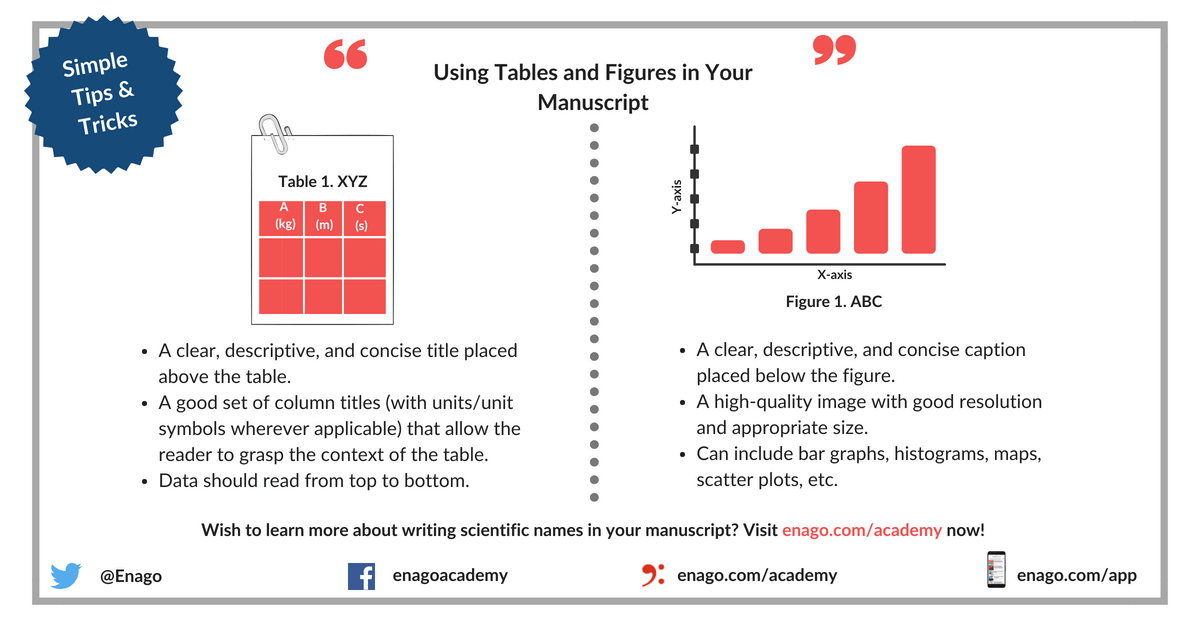When Writing an Article Review How Do I Include a Figure

Research papers are oftentimes based on copious amounts of data that can be summarized and easily read through tables and graphs. When writing a research paper, it is important for data to be presented to the reader in a visually appealing way. The information in figures and tables, however, should not be a repetition of the data found in the text. There are many ways of presenting data in tables and figures, governed by a few unproblematic rules. An APA research paper and MLA research paper both require tables and figures, but the rules around them are different. When writing a enquiry paper, the importance of tables and figures cannot be underestimated. How practise you know if you need a table or effigy? The dominion of thumb is that if you cannot present your data in one or ii sentences, then y'all need a table.
Using Tables
Tables are easily created using programs such as Excel. Tables and figures in scientific papers are wonderful means of presenting information. Effective data presentation in research papers requires understanding your reader and the elements that comprise a table. Tables have several elements, including the legend, column titles, and body. As with bookish writing, information technology is also but as of import to structure tables so that readers can easily sympathize them. Tables that are disorganized or otherwise confusing will make the reader lose interest in your work.
- Title: Tables should have a clear, descriptive title, which functions equally the "topic sentence" of the table. The titles can exist lengthy or brusk, depending on the discipline.
- Column Titles: The goal of these championship headings is to simplify the table. The reader's attending moves from the title to the column title sequentially. A good set of cavalcade titles will let the reader to quickly grasp what the table is about.
- Table Trunk: This is the main area of the table where numerical or textual data is located. Construct your table so that elements read from up to down, and not across.
Related: Washed organizing your research information finer in tables? Check out this post on tips for citing tables in your manuscript now!
The placement of figures and tables should be at the center of the folio. It should be properly referenced and ordered in the number that it appears in the text. In add-on, tables should be fix autonomously from the text. Text wrapping should not be used. Sometimes, tables and figures are presented subsequently the references in selected journals.
Using Figures
Figures can have many forms, such as bar graphs, frequency histograms, scatterplots, drawings, maps, etc. When using figures in a research paper, always think of your reader. What is the easiest figure for your reader to understand? How can you nowadays the data in the simplest and most effective way? For example, a photograph may be the best choice if you desire your reader to understand spatial relationships.
- Effigy Captions: Figures should be numbered and have descriptive titles or captions. The captions should exist succinct enough to understand at the first glance. Captions are placed under the figure and are left justified.
- Image: Cull an paradigm that is simple and easily understandable. Consider the size, resolution, and the image'southward overall visual bewitchery.
- Additional Information: Illustrations in manuscripts are numbered separately from tables. Include any information that the reader needs to understand your effigy, such as legends.
Common Errors in Research Papers
Effective data presentation in research papers requires understanding the mutual errors that make data presentation ineffective. These common mistakes include using the wrong type of figure for the information. For instance, using a scatterplot instead of a bar graph for showing levels of hydration is a mistake. Another mutual mistake is that some authors tend to italicize the table number. Remember, just the tabular array title should exist italicized. Another mutual mistake is failing to attribute the table. If the table/effigy is from some other source, simply put "Note. Adapted from…" underneath the table. This should help avert whatsoever bug with plagiarism.
Using tables and figures in enquiry papers is essential for the paper's readability. The reader is given a risk to understand data through visual content. When writing a inquiry paper, these elements should be considered equally office of adept inquiry writing. APA research papers, MLA research papers, and other manuscripts require visual content if the data is too complex or voluminous. The importance of tables and graphs is underscored by the main purpose of writing, and that is to be understood.

Sign-upward to read more
Subscribe for free to get unrestricted admission to all our resources on research writing and bookish publishing including:
- 2000+ blog articles
- l+ Webinars
- ten+ Adept podcasts
- fifty+ Infographics
- Q&A Forum
- 10+ eBooks
- ten+ Checklists
- Research Guides
Delight enter a valid personal email
Nosotros hate spam too. We promise to protect your privacy and never spam yous.
Source: https://www.enago.com/academy/how-to-use-tables-and-figures-to-effectively-organize-data-in-research-papers/


Post a Comment for "When Writing an Article Review How Do I Include a Figure"